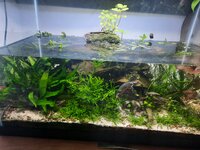GA Science Teacher
New member
I am working to make a 75 gallon native tank for a classroom setup, as naturally as possible, including both sirens and a few representatives of other SE native aquatic life. It's important to the lessons I want to use to have as many of the natural cycles as possible cycling in the tank. I'm opening to using either one lesser or several dwarves, whatever would work best for my objectives. I'd appreciate any and all advice on the following:
1. A heavily planted tank is a must for me, in order to allow natural nutrient cycles to take place. I've seen some people say that plants don't work with lesser sirens because they dig too much, but others seem to use them fine. Are there any guidelines I can use? Any recommendations on plants? I would prefer native plants but am willing to use other options.
2. In order to have a self-sustaining tank, I would prefer to use Walstad method with dirt under the sand. But is that impossible with sirens due to their digging and is sand-only the only reasonable option? Perhaps dirt-under-sand could work with dwarves, but not lessers?
3. With heavily-planted, well-cycled tank with chemical levels carefully monitored, are water changes still necessary or not?
4. Which native fish could potentially work as aquarium-mates with either dwarves or lessers? Which native invertebrates may work? It seems that some people have tried fish successfully before, but if you are absolutely certain it wouldn't work, then I'm open to installing a glass divider halfway through the tank and keeping a lesser or several dwarves on one side and the fish on the other side. The extra advantage there could be more water movement on the fish side and less on the siren side. If I did that, where would it be ideal to keep the divider boundaries? Just down to the substrate, halfway down the substrate, or all the way down to the bottom? All the way to the top of the water, several inches above the top, or could I allow a bit of water at the top to cycle across both tanks?
5. Considering everything I've said above, what would my lid setup look like? I'd need some sort of lighting to maintain the plants, so is it a better idea to find a lid with installed lights to meet my needs, or should I just use a well-fitting screen with separate housed lamps shining above it?
6. What would the best filter option be, all above information considered?
I believe that's all the questions I have. From all the information I've read online, things like temps and feeding seem pretty clear.
1. A heavily planted tank is a must for me, in order to allow natural nutrient cycles to take place. I've seen some people say that plants don't work with lesser sirens because they dig too much, but others seem to use them fine. Are there any guidelines I can use? Any recommendations on plants? I would prefer native plants but am willing to use other options.
2. In order to have a self-sustaining tank, I would prefer to use Walstad method with dirt under the sand. But is that impossible with sirens due to their digging and is sand-only the only reasonable option? Perhaps dirt-under-sand could work with dwarves, but not lessers?
3. With heavily-planted, well-cycled tank with chemical levels carefully monitored, are water changes still necessary or not?
4. Which native fish could potentially work as aquarium-mates with either dwarves or lessers? Which native invertebrates may work? It seems that some people have tried fish successfully before, but if you are absolutely certain it wouldn't work, then I'm open to installing a glass divider halfway through the tank and keeping a lesser or several dwarves on one side and the fish on the other side. The extra advantage there could be more water movement on the fish side and less on the siren side. If I did that, where would it be ideal to keep the divider boundaries? Just down to the substrate, halfway down the substrate, or all the way down to the bottom? All the way to the top of the water, several inches above the top, or could I allow a bit of water at the top to cycle across both tanks?
5. Considering everything I've said above, what would my lid setup look like? I'd need some sort of lighting to maintain the plants, so is it a better idea to find a lid with installed lights to meet my needs, or should I just use a well-fitting screen with separate housed lamps shining above it?
6. What would the best filter option be, all above information considered?
I believe that's all the questions I have. From all the information I've read online, things like temps and feeding seem pretty clear.


